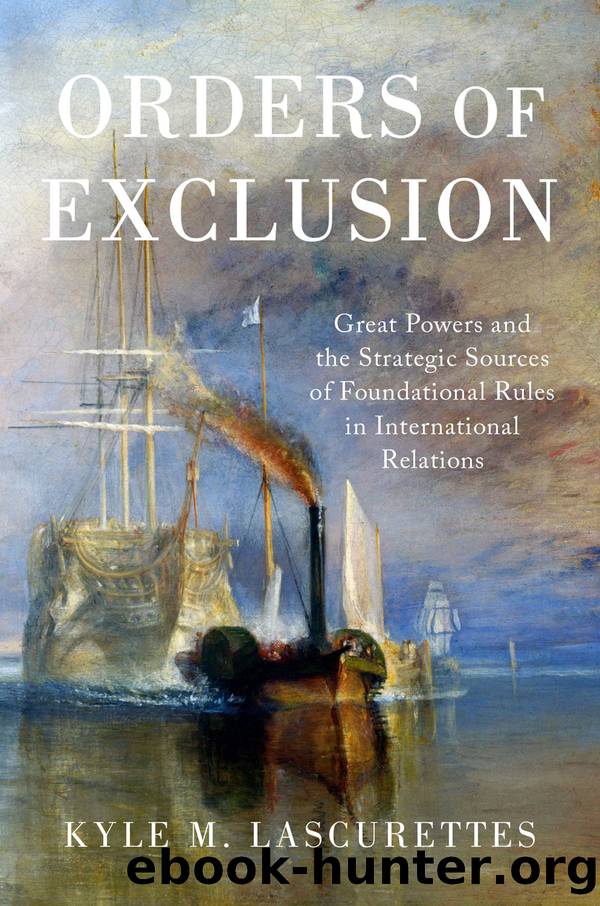Orders of Exclusion by Kyle M. Lascurettes;

Author:Kyle M. Lascurettes;
Language: eng
Format: epub
Publisher: OUP Premium
Published: 2020-02-15T00:00:00+00:00
7
Birthing the Liberal International Order
for many observers of history, the liberal order forged after the Second World War appears to be fundamentally distinct from international orders of the past. Policymakers and scholars often attribute this break to a simple, single development: the United States of America becoming the first truly liberal hegemonic actor in history. A âdistinctive type of international order was constructed after World War II,â argues John Ikenberry. At this moment of opportunity, âthe United States engaged in the most ambitious and far-reaching liberal order building the world had yet seenâ to create âa hierarchical system that was built on both American power dominance and liberal principles of governance.â While America would hold some privileges as its natural leader, âits power advantages were muted and mediated by an array of postwar rules, institutions, and reciprocal political processesâ where, for the first time, âweaker and secondary states were given institutionalized access to the exercise of [the hegemonâs] power.â1 Many prominent American politicians and foreign policy practitionersâas well as a good number of IR scholars2âagree with this sentiment, which has practically been embraced as conventional wisdom. When it comes to international order building, this consensus suggests, the United States of America simply âdoes it differently.â
One of the many elements that make this case unique is the fact that there were actually multiple layers of order built after World War II. More specifically, there was a universalist global order visionâmanifested in the United Nations systemâand a smaller Western order visionâcomprised of the Bretton Woods economic and NATO security systems. Observers often posit that these layers were complementary, representing an evolving but not contradictory strategy by the United States to build a multilayered institutional order that would preserve world peace and enhance global prosperity. For instance, Ikenberry conceives of the Western vision as an inner layer, a âWestern core of the order . . . built among democratic societies and organized around layers of institutionsâ that would gradually allow the thicker principles of that core to diffuse outward to other regions of the world.3
On both of these points reflecting the conventional wisdom, I beg to differ. Against the first point, I argue that the order changes advocated by American leaders after the Second World Warâwhile they were certainly the most far-reaching and complex the world has ever knownâcan nonetheless still be best explained by the logic of excluding threats. That makes American motives for order construction unexceptional compared to those of prior order builders. Against the second point, I argue that the Western order was never intended to fit within the global one. Instead, Western order emerged as an alternative to global order only when that system unexpectedly failed to deliver on what its founders had envisioned. The story of order building after World War II, I posit, is the extraordinary transition away from a vision of global order to a more circumscribed and exclusive Western vision of order.
Bringing both of these points together, I argue in this chapter that this transition
Download
This site does not store any files on its server. We only index and link to content provided by other sites. Please contact the content providers to delete copyright contents if any and email us, we'll remove relevant links or contents immediately.
Collaborating with Parents for Early School Success : The Achieving-Behaving-Caring Program by Stephanie H. McConaughy; Pam Kay; Julie A. Welkowitz; Kim Hewitt; Martha D. Fitzgerald(854)
Entrepreneurship Education and Training: The Issue of Effectiveness by Colette Henry Frances Hill Claire Leitch(581)
Adding Value to Policy Analysis and Advice by Claudia Scott; Karen Baehler(487)
Race and American Political Development by unknow(473)
Sociological Perspectives of Health and Illness by Constantinos N. Phellas(467)
American Government and Politics Today by Steffen W. Schmidt Mack C. Shelley Barbara A. Bardes(462)
Human and Global Security : An Exploration of Terms by Peter Stoett(451)
Materializing the Middle Passage by Jane Webster;(443)
Control Of Oil - Hardback by Kayal(434)
Advances in Child Development and Behavior, Volume 37 by Patricia J. Bauer(386)
The Catholic Church and European State Formation, AD 1000-1500 by Jørgen Møller(381)
The World According to China by Elizabeth C. Economy(368)
Left Is Not Woke by Susan Neiman(353)
The Disappearance of Rituals: A Topology of the Present by Byung-Chul Han(350)
Theories of Counseling and Psychotherapy: A Case Approach by Nancy L. Murdock(350)
Turkey's Relations with the West and the Turkic Republics: The Rise and Fall of the Turkish Model by Idris Bal(344)
Application of classical statistics, logratio transformation and multifractal approaches to delineate geochemical anomalies in the Zarshuran gold district, NW Iran by unknow(340)
Cross-Cultural Child Development for Social Workers by Lena Robinson(337)
Japan's Ainu Minority in Tokyo by Mark K. Watson(321)
